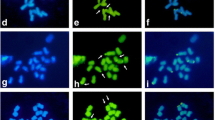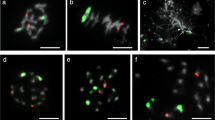Abstract
Southern hybridization and genomic in situ hybridization (GISH) have demonstrated that ‘Purissima’ (2n = 2x = 24) is an interspecific hybrid comprised of one genome of Tulipa (T.) gesneriana and one genome of T. fosteriana. Backcrossing T. gesneriana with ‘Purissima’ was partially successful. Simultaneous GISH and fluorescence in situ hybridization (FISH) distinguished chromosomes from both parent genomes, as well as recombinant chromosomes, in interspecific hybrids and their progeny. Chromosome recombination was observed in all cultivars except ‘Purissima’ and ‘Kouki’ (2n = 3x = 36). ‘Kouki’ (2n = 3x = 36) had two genomes of the T. gesneriana and a single genome of the T. fosteriana. The number of nonrecombinant T. fosteriana chromosomes in ‘Judith Leyster’ (2n = 4x = 48) and ‘Purissima’ progeny varied from two in ‘Hatsuzakura’ to six in ‘Kikomachi’ and ‘Momotaro’. The number and type of recombinant chromosomes also differed among cultivars. The total number of translocations ranged from one in ‘Kikomachi’ to six in ‘Hatsuzakura’. Each was a combination of a single T. fosteriana fragment and a single T. gesneriana fragment, indicating that they resulted from a single crossover event. Sequential GISH and FISH analysis with rDNA probes yielded chromosome-specific markers that were used to identify most of the chromosomes in ‘Purissima’ progeny. This is the first report of introgression of T. fosteriana chromatin into the T. gesneriana genome.




Similar content being viewed by others
Abbreviations
- FDR:
-
First division restitution
- FISH:
-
Fluorescence in situ hybridization
- GISH:
-
Genomic in situ hybridization
- PMC:
-
Pollen mother cell
- T. :
-
Tulipa
References
Alix K, Ryder CD, Moore J, King GJ, Heslop-Harrison JS (2005) The genomic organization of retrotransposons in Brassica oleracea. Plant Mol Biol 59:839–851
Anamthawat-Jonsson K, Thorsson A (2003) Natural hybridisation in birch: triploid hybrids between Betula nana and B. pubescens. Plant Cell Tissue Organ Culture 75:99–107
Barba-Gonzalez R, Ramanna MS, Visser RGF, Van Tuyl JM (2005) Intergenomic recombination in the F1 hybrids of Oriental Asiatic lily hybrids (Lilium) and its significance for genetic variation in the BC1 progenies as revealed by GISH and FISH. Genome 48:884–894
Barba-Gonzalez R, Van Silfhout AA, Ramanna MS, Visser RGF, Van Tuyl JM (2006) Progenies of allotriploids of Oriental × Asiatic lilies (Lilium) examined by GISH analysis. Euphytica 151:243–250
Bennett ST, Kenton AY, Bennett MD (1992) Genomic in situ hybridization reveals the allopolyploid nature of Milium montianum (Geramineae). Chromosoma 101:420–424
Bryan EB (2002) Bulbs. Timber Press, Inc, Portland, Oregon, pp 454–462
Brysting AK, Holst-Jensen A, Leitch I (2000) Genomic origin and organization of the hybrid Poa jemtlandica (Poaceae) verified by genomic in situ hybridization and chloroplast DNA sequences. Ann Bot 85:439–445
Chase MW, Knapp S, Cox AV, Clarkson JJ, Butsko Y, Joseph J, Savolainen V, Parokonny AS (2003) Molecular systematics, GISH and the origin of hybrid taxa in Nicotiana (Solanaceae). Ann Bot 92:107–127
Custers JBM, Eikelboom W, Bergervoet JHW, van Eijk JP (1995) Embryo-rescue in the genus Tulipa L.; successful direct transfer of T. kaufmanniana Regel germplasm into T. gesneriana L. Euphytica 82:253–261
Desel C, Jansen R, Dedong G, Schmidt T (2002) Painting of parental chromatin in Beta hybrids by multi-colour fluorescence in situ hybridization. Ann Bot 89:171–181
Hasterok R, Jenkins G, Longdon T, Jones RN, Maluszynska J (2001) Ribosomal DNA is an effective marker of Brassica chromosomes. Theor Appl Genet 103:486–490
Hasterok R, Draper J, Jenkins G (2004) Laying the cytotaxonomic foundations of a new model grass, Brachypodium distachyon (L.) Beauv. Chromosome Res 12:397–403
Hasterok R, Ksiazczyk T, Wolny E, Maluszynska J (2005) FISH and GISH analysis of Brassica genomes. Acta Biol Cracovinsia Series Botanica 41:185–192
Kamstra SA, Kuipers AGJ, De Jeu MJ, Rammana MS, Jacobsen E (1999) The extent and position of homoeologous recombination in a distant hybrid of Alstroemeria: a molecular cytogenetic assessment of first generation backcross progenies. Chromosoma 108:52–63
Kamstra SA, De Jong JH, Jacobsen E, Ramanna MS, Kuipers AGJ (2004) Meiotic behaviour of individual chromosomes in allotriploid Alstroemeria hybrids. Heredity 93:15–21
Karlov GI, Khrustaleva LI, Lim KB, Van Tuyl JM (1999) Homologous recombination in 2n-gametes producing interspecific hybrids of Lilium (Liliaceae) studied by genomic in situ hybridization (GISH). Genome 42:681–686
Kho YO, Baer J (1971) Incompatibility problems in species crosses of Tulips. Euphytica 20:30–35
Killingback S (1990) Tulips—an illustrated identifier and guide to their cultivation. Apple Press, London
Kimura K (2002) Tulip (in Japanese). Nobunkyo, Tokyo
Kuipers AGJ, Van Os DPM, de Jong JH, Ramanna MS (1997) Molecular cytogenetics of Alstroemeria: identification of parental genomes in interspecific hybrids and characterization of repetitive DNA families in constitutive heterochromatin. Chromosome Res 5:31–39
Levan AK, Fredga K, Sandberg AA (1964) Nomenclature for centromeric position of chromosomes. Hereditas 52:201–220
Li CB, Zhang DM, Ge S, Lu BR, Hong DY (2001) Identification of genome constitution of Oriza malampuzhaensis, O. minuta, and O. punctata by multicolour genomic in situ hybridization. Theor Appl Genet 103:204–211
Lim KB, Chung JD, Van Kronenburg BCE, Ramanna MS, de Jong JH, Van Tuyl JM (2000) Introgression of Lilium rubellum Baker chromosomes into L. longiflorum Thunb.: a genome painting study of the F1 hybrid, BC1 and BC2 progenies. Chromosome Res 8:119–125
Lim KB, Ramanna MS, de Jong JH, Jacobsen E, Van Tuyl JM (2001) Indeterminate meiotic restitution (IMR): a novel type of meiotic nuclear restitution mechanism detected in interspecific lily hybrids by GISH. Theor Appl Genet 103:219–230
Lim KB, Ramanna MS, Jacobsen E, Van Tuyl JM (2003a) Evaluation of BC2 progenies derived from 3x−2x and 3x−4x crosses of Lilium hybrids: a GISH analysis. Theor Appl Genet 106:568–574
Lim KB, Ramanna MS, Van Tyul JM (2003b) Homoeologous recombination in interspecific hybrids of Lilium. Korean J Breed 35:8–12
Maluszynska J, Hasterok R (2005) Identification of individual chromosomes and parental genomes in Brassica juncea using GISH and FISH. Cytogenet Genome Res 109:310–314
Marasek A, Hasterok R, Wiejacha K, Orlikowska T (2004) Determination by GISH and FISH of hybrid status in Lilium. Hereditas 140:1–7
Marasek A, Mizuochi H, Okazaki K (2006) The origin of Darwin hybrid tulips analyzed by flow cytometry, karyotype analyses and genomic in situ hybridization. Euphytica 151:279–290
Marasek A, Okazaki K (2007) GISH Analysis of Hybrids Produced by Interspecific Hybridization between Tulipa gesneriana and T. fosteriana. In: Mercuri A, Schiva T (eds) Proc. XXIInd Intl. Eucaripa Symposium (Section Ornamentals) on Breeding for Beauty, September 2006. Acta Horticulturea 743:133–137
Mizuochi H, Marasek A, Okazaki K (2007) Molecular cloning of Tulipa fosteriana rDNA and subsequent FISH analysis yields cytogenetic organization of 5S rDNA and 45S rDNA in T. gesneriana and T. fosteriana. Euphytica 155:235–248
Moscone EA, Klein F, Lambrou M, Fuchs J, Schweizer D (1999) Quantitative karyotyping and dual-color FISH mapping of 5S and 18S–25S rDNA probes in the cultivated Phaseolus species (Leguminosae). Genome 42:1224–1233
Mukai Y, Nakamura Y, Yamamoto M (1993) Simultaneous discrimination of the three genomes in hexaploid wheat by multicolour fluorescence in situ hybridization using total genomic and highly repeated DNA probes. Genome 36:489–494
Murray MG, Thompson WF (1980) Rapid isolation of high-molecular-weight plant DNA. Nucleic Acid Res 8:4321–4325
Okazaki K (2005) New aspects of tulip breeding: embryo culture and polyploidy. Acta Hort 673:127–140
Okazaki K, Kurimoto K, Miyajima I, Enami A, Mizuochi H, Matsumoto Y, Ohya H (2005) Induction of 2n pollen in tulips by arresting meiotic process with nitrous oxide gas. Euphytica 143:101–114
Ran Y, Hammett KRW, Murray BG (2001) Phylogenetic analysis and karyotype evolution in the genus Clivia (Amaryllidaceae). Ann Bot 87:823–830
Sayama H, Moue T, Nishimura Y (1982) Cytological study in Tulipa gesneriana and T. fosteriana. Jpn J Breed 32:26–34
Schwarzacher T, Heslop-Harrison P (2000). Practical in situ hybridization. The Bath Press, Bath
Snowdon RJ, Kohler W, Friedt W, Kohler A (1997) Genomic in situ hybridization in Brassica amphidiploids and interspecific hybrids. Theor Appl Genet 95:1320–1324
Straathof TO, Eikelboom W (1997) Tulip breeding at CPRO-DLO. Daffodil Tulip Yearbook 8:27–33
Thomas HM, Morgan WG, Meredith MR, Humphreys MW, Thomas H, Leggett JM (1994) Identification of parental and recombined chromosomes in hybrid derivatives of Lolium multiflorum and Festuca pratensis by genomic in situ hybridization. Theor Appl Genet 88:909–913
Van Eijk JP, Von Raamsdonk LWD, Eikelboom W, Bino RJ (1991) Interspecific crosses between Tulipa gesneriana cultivars and wild Tulipa species: a survey. Sex Plant Reprod 4:1–5
Van Scheepen J (1996) Classified list and international register of tulip names. General Bulbgrowers’ Association, KAVB Hillegom, Netherlands
Zeilinga AE, Schouten HP (1968) Polyploidy in garden tulips. I. Survey of Tulipa varieties for polyploids. Euphytica 17:252–264
Zwierzykowski Z, Tayyar R, Brunell M, Lukaszewski AJ (1998) Genome recombination in intergeneric hybrids between tetraploid Festuca pratensis and Lolium multiflorum. J Heredity 89:324–328
Acknowledgements
This research was supported by the Japanese Society for the Promotion of Science (JSPS fellowship award to A. M., ID No. P 05186).
Author information
Authors and Affiliations
Corresponding author
Rights and permissions
About this article
Cite this article
Marasek, A., Okazaki, K. Analysis of introgression of the Tulipa fosteriana genome into Tulipa gesneriana using GISH and FISH. Euphytica 160, 217–230 (2008). https://doi.org/10.1007/s10681-007-9539-7
Received:
Accepted:
Published:
Issue Date:
DOI: https://doi.org/10.1007/s10681-007-9539-7




